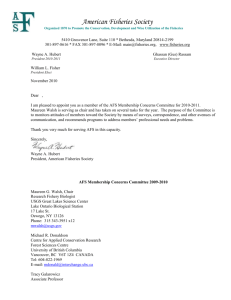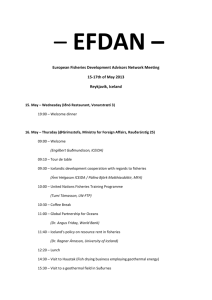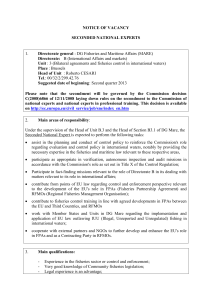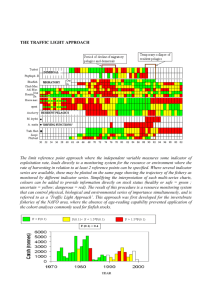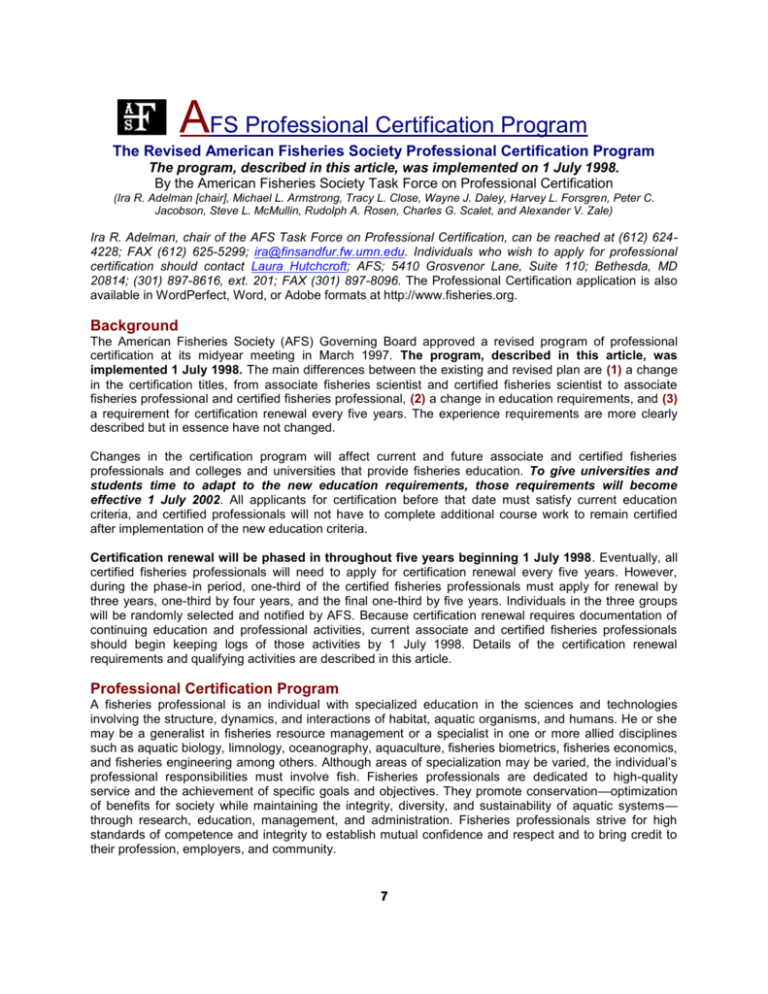
AFS Professional Certification Program
The Revised American Fisheries Society Professional Certification Program
The program, described in this article, was implemented on 1 July 1998.
By the American Fisheries Society Task Force on Professional Certification
(Ira R. Adelman [chair], Michael L. Armstrong, Tracy L. Close, Wayne J. Daley, Harvey L. Forsgren, Peter C.
Jacobson, Steve L. McMullin, Rudolph A. Rosen, Charles G. Scalet, and Alexander V. Zale)
Ira R. Adelman, chair of the AFS Task Force on Professional Certification, can be reached at (612) 6244228; FAX (612) 625-5299; ira@finsandfur.fw.umn.edu. Individuals who wish to apply for professional
certification should contact Laura Hutchcroft; AFS; 5410 Grosvenor Lane, Suite 110; Bethesda, MD
20814; (301) 897-8616, ext. 201; FAX (301) 897-8096. The Professional Certification application is also
available in WordPerfect, Word, or Adobe formats at http://www.fisheries.org.
Background
The American Fisheries Society (AFS) Governing Board approved a revised program of professional
certification at its midyear meeting in March 1997. The program, described in this article, was
implemented 1 July 1998. The main differences between the existing and revised plan are (1) a change
in the certification titles, from associate fisheries scientist and certified fisheries scientist to associate
fisheries professional and certified fisheries professional, (2) a change in education requirements, and (3)
a requirement for certification renewal every five years. The experience requirements are more clearly
described but in essence have not changed.
Changes in the certification program will affect current and future associate and certified fisheries
professionals and colleges and universities that provide fisheries education. To give universities and
students time to adapt to the new education requirements, those requirements will become
effective 1 July 2002. All applicants for certification before that date must satisfy current education
criteria, and certified professionals will not have to complete additional course work to remain certified
after implementation of the new education criteria.
Certification renewal will be phased in throughout five years beginning 1 July 1998. Eventually, all
certified fisheries professionals will need to apply for certification renewal every five years. However,
during the phase-in period, one-third of the certified fisheries professionals must apply for renewal by
three years, one-third by four years, and the final one-third by five years. Individuals in the three groups
will be randomly selected and notified by AFS. Because certification renewal requires documentation of
continuing education and professional activities, current associate and certified fisheries professionals
should begin keeping logs of those activities by 1 July 1998. Details of the certification renewal
requirements and qualifying activities are described in this article.
Professional Certification Program
A fisheries professional is an individual with specialized education in the sciences and technologies
involving the structure, dynamics, and interactions of habitat, aquatic organisms, and humans. He or she
may be a generalist in fisheries resource management or a specialist in one or more allied disciplines
such as aquatic biology, limnology, oceanography, aquaculture, fisheries biometrics, fisheries economics,
and fisheries engineering among others. Although areas of specialization may be varied, the individual’s
professional responsibilities must involve fish. Fisheries professionals are dedicated to high-quality
service and the achievement of specific goals and objectives. They promote conservation—optimization
of benefits for society while maintaining the integrity, diversity, and sustainability of aquatic systems—
through research, education, management, and administration. Fisheries professionals strive for high
standards of competence and integrity to establish mutual confidence and respect and to bring credit to
their profession, employers, and community.
7
Certification is widely practiced by the professions as one means of setting standards and guidelines for
professional recognition. It serves to upgrade the professional image and is a mark of accomplishment.
Certification also is a mechanism to demonstrate responsible peer evaluation. The specific objectives of
certification are as follows: (1) to provide governmental and nongovernmental agencies and
organizations, private firms, courts, and the general public with a definitive minimum standard of
experience and education for fisheries professionals; and (2) to foster broader recognition of fisheries
professionals as well-educated and experienced, acting in the best interest of the public.
The AFS has worked to advance conservation of fishes and aquatic resources around the world for more
than a century. With almost 10,000 members, the Society promotes educational, scientific, and
technological development of all facets of fisheries science and management.
Certification Description
Two tiers of certification are available. An applicant who satisfies course work and degree (minimum of
B.S. or B.A.) requirements but has insufficient or no experience may become an Associate Fisheries
Professional (AFP). An applicant who satisfies course work and degree requirements and has a specific
number of years of qualifying experience and a specific number of professional development quality
points (PDQPs) may become a Certified Fisheries Professional (CFP).
I. Associate Fisheries Professional (AFP)—Applicants must meet the academic (course and degree)
requirements as prescribed under Guidelines for Professional Certification.
II. Certified Fisheries Professional (CFP)—In addition to the academic requirements mentioned above,
minimum experience and professional development requirements are listed under Guidelines for
Professional Certification.
Although the same application form is used, applicants must designate the certification category, AFP or
CFP, for which they are applying. If uncertain (because of course work variances, questions about
qualifying/nonqualifying experience, professional development, etc.) as to the tier for which they qualify, a
third choice may be indicated. This choice means that the applicant accepts the level of certification (AFP
or CFP) granted by the AFS after its review.
Associate Fisheries Professional certification may be retained for a maximum of eight years, at which time
the requirements for a Certified Fisheries Professional must be met and applied for in order to retain any
AFS certification. The AFP must submit a new application with all requested information, with the
exception of the course list and transcripts (unless further education has been acquired).
Guidelines for Professional Certification
Minimum course requirements 1, 2, 3, 4
(A) Fisheries and aquatic sciences courses. A minimum of four (4) courses, for a total of twelve (12)
semester or eighteen (18) quarter hours. Of the four (4) courses, at least two (2) must be directly related
to fisheries science (e.g., fisheries science, ichthyology, fisheries management, fish ecology, aquaculture
or fish culture, fish diseases, etc.), and at least one (1) must cover principles of fisheries science and
management. Therefore, a maximum of two (2) nonfisheries, aquatic science courses (e.g., limnology,
aquatic entomology, stream ecology, etc.) can be used in this category.
(B) Other biological sciences courses that, when added to the preceding courses, total to thirty (30)
semester or forty-five (45) quarter hours.
(C) Physical sciences courses. Fifteen (15) semester or twenty-three (23) quarter hours.
8
(D) Mathematics and statistics courses. Six (6) semester or nine (9) quarter hours, including one (1)
calculus and one (1) statistics course or two (2) statistics courses. This new educational requirement will
become effective July 1, 2002 until then please use the current guidelines. The guidelines to use before
July 1, 2002 are six (6) semester or nine (9) quarter hours, including college algebra or calculus
and one course in statistics.
(E) Communications courses. Nine (9) semester or thirteen (13) quarter hours. Three (3) semester or
five (5) quarter hours may be taken in communications-intensive courses (see explanation below) if
officially designated as such by the university or college at which they were taken.
(F) Human dimensions courses. Six semester or nine quarter hours. This new educational requirement
will become effective July 1, 2002.
Description of course categories
The fisheries and aquatic sciences category must include four courses related to understanding or
manipulating aquatic ecosystems. Courses such as fisheries science, limnology, oceanography, fisheries
management, ichthyology, aquaculture or fish culture, taxonomy of aquatic organisms, and aquatic
ecology are acceptable. Courses such as vertebrate biology, wildlife management, ornithology, general
ecology, etc. do not belong in this category. The course designated as fulfilling the principles of fisheries
science/management requirement must include fisheries population dynamics and habitat assessment
and management. It must be an upper-division course (i.e., junior, senior, or graduate level) and must be
at least three semester or four quarter hours. All combined fisheries and wildlife courses count as if they
were 100% fisheries.
Physical sciences category courses include chemistry, physics, soils, geology, hydrology, earth
science, astronomy, and meteorology.
Mathematics and statistics category courses must include one course each in calculus and statistics
or two statistics courses. (Effective after July 1, 2002)
The communications category includes courses such as composition, technical writing, and verbal
communication. Literature, foreign language, other humanities courses, and seminars do not count.
Communications-intensive courses are defined as those whose primary subject is not communications
but rather have intensive communications requirements and are officially designated as such by the
university. Officially designated means that the university has a formal listing of courses as
communications-intensive or a similar title, and that certain criteria have been met by those courses to
receive such designation. Officially designated communications-intensive courses credited in this
category also may be counted in another category. For example, if a fisheries management course is
designated as communications-intensive, the course may count for full credit in both the fisheries and
aquatic science category and the communications category.
Human dimensions category courses deal with social aspects of natural resource science and
management. They include courses such as named courses in human dimensions of natural resources
and courses in policy, planning, administration, law, ethics, public relations, leadership, conflict resolution,
natural resource economics, and others related to natural resource management. Introductory social
science courses such as sociology and psychology do not qualify. Courses in this group may be doublecounted as fulfilling course requirements in the fisheries and aquatic sciences category, but the credit
hours must be apportioned between the two categories based on the percentage time devoted to the
human dimensions topic. (Effective after July 1, 2002)
9
Minimum Degree and Experience Requirements for Certified Fisheries
Professionals
(1) A bachelor of science or bachelor of arts degree, plus five years of full-time qualifying experience,
post-bachelor’s degree
or
(2) A master of science or a master of arts degree, plus four years of full-time qualifying experience, postbachelor’s degree
or
(3) A doctor of philosophy degree, plus two years of full-time qualifying experience, post-bachelor’s
degree.
Description of qualifying experience
Qualifying experience is that in which the candidate applies current knowledge in the fisheries sciences
within the context of fisheries management, research, education, or administration. Because the fisheries
profession is so varied in specialization, identifying qualifying experience cannot be easily generalized.
Below are types and examples of qualifying experience in each area:
Management involves the application of fisheries science principles (e.g., population dynamics, aquatic
biology, limnology, habitat assessment and manipulation, human dimensions, fish culture, biometrics)
toward the accomplishment of specific fisheries management goals and objectives. The candidate should
have responsible charge or supervision over the planning, implementation, and assessment of projects.
Responsible charge or supervision is defined as the direction of work such that the successful completion
of the work depends on decisions made by the professional with limited oversight, direction, or approval
of others. Projects include recreational and commercial fisheries investigations and management, fish
culture, environmental assessment, habitat restoration or enhancement, and fish disease management.
Qualifying experience requires that the candidate use independent judgment and action.
Research involves responsible charge or supervision of field or laboratory fisheries research projects.
Qualifying experience includes oversight responsibility for design, implementation, analysis, and report
writing. Research projects should either be published in a recognized, peer-reviewed journal or used by
the employer for the purpose of improved scientific methodology, regulatory decision making, or resource
management practices.
Education involves college-level teaching of various facets of fisheries management, research, and
administration. Education also may involve development and delivery of educational programs in fisheries
for dissemination to the general public or particular stakeholders.
Administration involves direct-line authority over other fisheries professionals engaged in activities or
programmatic responsibilities over activities that qualify for certification described under the headings of
management, research, and education given above. Candidates must have responsibility and decisionmaking authority of such magnitude as districtwide, regional, statewide, or national fisheries programs.
Independent judgment and consequences of actions must be present.
Minimum Professional Development Requirements
(Will be required as of July 1, 2000)
Description and criteria
Professional development is required of all Certified Fisheries Professionals (CFPs) to keep abreast of
developments in the field and to ensure continued enhancement of knowledge and skills throughout the
CFP’s career. Consequently, a CFP must submit evidence of professional development activities to
achieve and maintain certification.
A point system is used to evaluate professional development. Prior to initial certification as a CFP and
every five (5) years thereafter, a CFP must submit evidence of continued activity and development by
accumulating a minimum number of professional development quality points (PDQPs). Whereas a
minimum number of PDQPs must be obtained in activity Categories I and II (continuing education), the
10
remaining PDQPs must be distributed among at least two (2) of the remaining three (3) activity
categories. These categories and specific activities within the categories are listed below.
Category I. Continuing education—fisheries
Includes subjects directly related to fisheries science or management. Examples include fisheries
management, habitat management, fisheries economics, fish diseases, aquaculture or fish culture,
fisheries policy and law, aquatic ecology, etc.
Activities
Participation in short-courses or training
programs sponsored or conducted by
commercial organizations, professional
organizations/agencies,employers, or
universities
Attendance at annual or semiannual
meetings or special conferences of
professional societies, educational
organizations, etc.
Attendance at in-house meetings of
employer involving education on new
techniques or developments in the
profession
Completion of self-instruction audiovisuals
Attendance at seminars conducted by
experts in the subject
PDQPs
0.5 per hour of instruction
0.5 per hour of participation
0.5 per hour of participation
0.5 per hour of instruction
0.5 per hour of instruction
Category II. Continuing education—nonfisheries
Includes subjects that are not primarily fisheries oriented but are professionally enriching to the individual.
Examples include computer science and statistics, managerial and leadership skills, public speaking,
problem-solving, public relations, marketing, planning, and other related natural resource disciplines such
as forestry, wildlife, etc.
Activities
Participation in short courses or training
programs sponsored or conducted by
commercial organizations, professional
organizations/agencies, employers, or
universities
Attendance at annual or semi-annual
meetings or special conferences of
professional societies, educational
organizations, etc.
Attendance at in-house meetings of
employers involving education on new
techniques or developments in the
profession
Completion of self-instruction audiovisuals
Attendance at seminars conducted by
experts in the subject
PDQPs
0.5 per hour of instruction
0.5 per hour of participation
0.5 per hour of participation
0.5 per hour of instruction
0.5 per hour of instruction
11
Category III. Oral communications in fisheries and nonfisheries subjects
Includes the development, preparation, and presentation of activities such as those described in
categories I and II. Context is any public meeting that is open to the general public or a select group of
invited participants. For fisheries subjects, the audience need not be fisheries professionals. For
nonfisheries subjects, the audience must be fisheries professionals. Multiple presentations of the same or
similar subject matter can only be credited once during a certification renewal period.
Activities
Author/coauthor of an oral or poster
presentation at a professional meeting
Author/coauthor of an oral or poster
presentation to a nonprofessional
audience
Organizer/instructor of a short course or
workshop
Instructor of a quarter- or semester-length
course
Author/producer of self-instruction
audiovisuals in fisheries
PDQPs
7
7
20
10 points per credit
maximum 30
20
Category IV. Written communications
Developing, writing, editing, reviewing, and publishing fisheries-oriented materials. The written material
need not be published, but it must be readily available to professional and nonprofessional audiences.
Activities
Author/coauthor of peer-reviewed article or
book chapter
Author/coauthor of a book/monograph
Editor/coeditor of a book/monograph
Author/coauthor of non-peer-reviewed
article in a magazine, brochure,
newspaper, etc.
Author/coauthor of an agency publication
or report
Reviewer or editor of an article that has
been submitted for publication
Book reviewer for a professional
publication
PDQPs
15
30
15
7
10
3
5
12
Category V. Service
Involves membership and active participation in fisheries or aquatic professional societies and
organizations, and community service that draws on the individual’s professional expertise in fisheries.
Community service may include contributions of professional expertise to civic groups, environmental
organizations, government, etc. Points are given for each year served in multiple-year appointments.
Activities
Holding the highest office in an
organization (including subdivisions),
(e.g., president, director, chair, journal
editor, etc.)
Holding the other offices in an
organization (including subdivisions),
(e.g., secretary, treasurer, associate editor,
newsletter editor, Committee chair, etc.)
Committee member
PDQPs
15
10
4
PDQP requirements (Will be required as of July 1, 2000)
PDQPs are required to both achieve and maintain status as a CFP. However, because only formal
education is needed to achieve AFP status, PDQPs are not required. At the time of application for the
initial CFP, the candidate must have accumulated 30 PDQPs during the previous 2 years. These must be
accumulated in at least two of the five categories. To maintain CFP status, 100 PDQPs must be
accumulated during the previous 5 years, and an application for certification renewal must be submitted
during the fifth year after previous certification. The 100 PDQPs must be distributed among the five
categories as follows:
Category I or II:
Category III:
Category IV:
Category V:
Total:
Minimum 35, maximum 60, combined
Maximum 35
Maximum 35
Maximum 35
Minimum 100
Professional development should be undertaken through various activities. The minimum requirement in
Category I or II combined is to ensure that a portion of the PDQPs are acquired through continuing
education as opposed to professional activities. The maximum requirements in the other categories
ensure that some PDQPs are obtained in at least three categories. CFP applicants will be provided with a
Professional Development Activity Form for documenting such activities for certification renewal.
Notification of the need for certification renewal will be sent to each AFP and CFP not less than twelve
(12) months prior to the renewal date. Applicants are responsible for maintaining their own records
and for verifying the accuracy of these records if requested to do so. Copies of meeting agendas,
certificates, registrations, etc. should be retained so they can be supplied if requested. Applicants are
encouraged to document activities that they believe most clearly fit the criteria, up to a maximum of 125
points. While the AFS Professional Code of Ethics is operative in maintaining the integrity of
documentation, the AFS may request verification to ensure process validity. Denial of certification renewal
may be appealed to the Board of Appeals. The applicant should prepare an appeal only if additional
information or further clarification of previously stated facts is provided.
Individuals who held the CFP designation for at least twenty (20) years (need not be consecutive) and
who are employed less than full time or are retired, may request emeritus status through which they can
maintain their CFP status without the renewal requirement.
Copyright © 1997 by the American Fisheries Society. All rights reserved.
13





